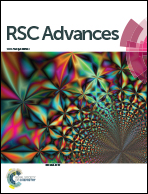Competitive cation binding to phosphatidylinositol-4,5-bisphosphate domains revealed by X-ray fluorescence†
Abstract
Phosphatidylinositol-4,5-bisphosphate (PIP2) is an important signaling phospholipid in the inner leaflet of the cell membrane. Due to the high negative charge of its headgroup, PIP2 strongly interacts with cellular cations. We have used synchrotron diffraction and fluorescence techniques to determine preferential cation binding to two-dimensional PIP2 templates. The natural, highly unsaturated PIP2 is manipulated as a Langmuir monolayer on a physiological buffer containing 100 mM KCl and varying amounts of Ca2+ and Mg2+. X-ray fluorescence shows an 800% surface enhancement in K+ concentration (bound to PIP2) compared to bulk concentration. Adding physiological levels of Ca2+( 1–100 μM) results in gradual replacement of K+ by Ca2+ ions, leading to a significant change in the organization of the PIP2 model membrane, while higher concentrations (100–1000 μM) lead to three orders of magnitude increase in surface [Ca2+]. Similar experiments with Mg2+ ions also show strong ion binding to PIP2 at physiological levels (1 mM) with a lesser structural effect. For mixed solutions of Mg2+ and Ca2+ we find that Ca2+ occupies the majority of binding sites. Remarkably we find that, with both 1 mM Mg2+ and 1 mM Ca2+ in the subphase there is still a 400% surface enrichment of K+ ions at the headgroup region.


 Please wait while we load your content...
Please wait while we load your content...